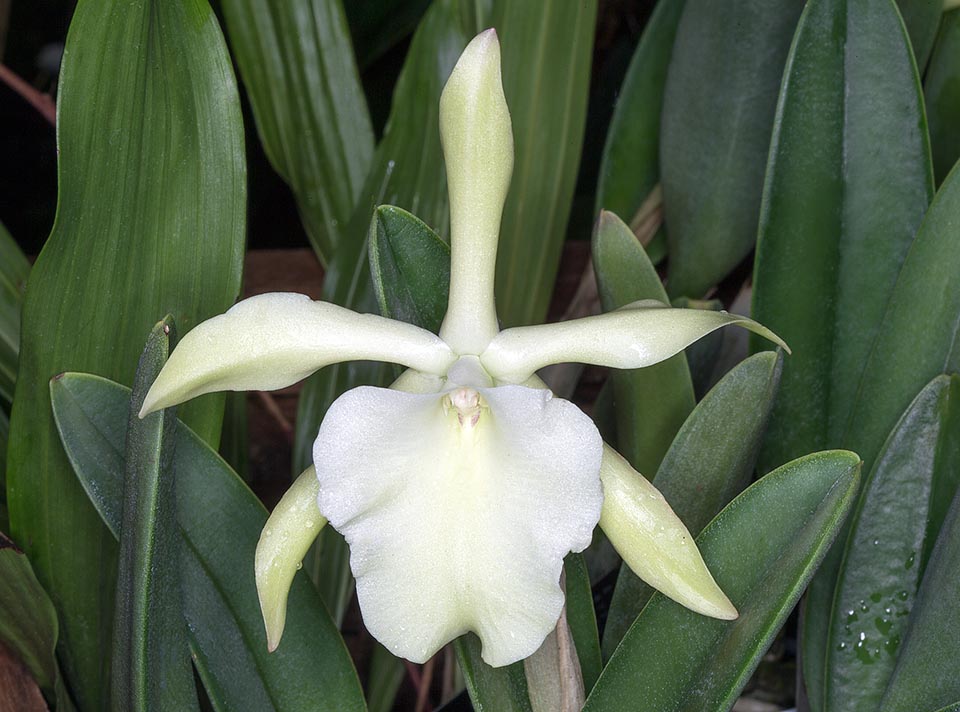Family : Orchidaceae

Text © Pietro Puccio

English translation by Mario Beltramini
The species is native to Belize, Guatemala, Honduras and Mexico (Chiapas, Oaxaca and Vera Cruz) where it grows in the mountain forests, between 800 and 1500 m of altitude, in areas characterized by seasonal climate.
The generic name is the combination of the Greek substantive ”ρύγχος” (rhynchos) = beak and of the genus Laelia , from which it differs due to the rostriform fruits; the specific name is the Latin adjective “glaucus, a, um” = glaucous, with reference to the colour of the leaves.
The Rhyncholaelia glauca (Lindl.) Schltr. (1918) is an epiphytic or terrestrial species with short and robust creeping rhizome from where originate oblong-clavate pseudobulbs, slightly compressed laterally, 3-10 cm long and of aboout 1 cm of diameter, provided at the apex of one single oblong leaf with obtuse apex, coriaceous, of green-light blue colour, 6-12,5 cm long and 2,5-3,5 cm broad. Erect terminal inflorescence, about 10 cm long, enclosed during the initial phase of growth into a membranaceous bract (spathe), 8-10 cm long, bearing one single flower, of 10-12 cm of diameter, waxy, with sepals and petals of white to greenish white, to violaceous white colour and white or greenish white labellum with a small triangular purple spot at the base; the flower emits an intense fragrance, particularly by night. Linear-lanceolate sepals with obtuse apex, 5-6,5 cm long and 1-1,5 cm broad, linear lanceolate petals with obtuse apex and slightly wavy margins, 5-6,5 cm long and 1,5-2 cm broad, with ovate or just trilobed labellum, with acute apex and wavy margins wrapping at the base of the column, about 5-5,5 cm long and 4 cm broad, and clavate column about 0,5 cm long. The flowers are pollinated mainly by moths belonging to the family of the Sphingidae (Latreille, 1802), the fruits are fusiform capsules 10-15 cm long.

Epiphytic or terrestrial of Central America, the Rhyncholaelia glauca has big greenish white flowers with pearly reflections. Intense night scent to attract the moths © Giuseppe Mazza
Species with big fragrant flowers and long lasting, 2-3 weeks, requires a cultivation locatioon well aerated with the 75-80 % of constant humidity during the whole year, high luminosity, also direct sun, excluding the central hours of the day, medium-high temperatures, with lowest night winter ones not under the 15 °C; a daily thermal excursion of 5 °C or more favours the blooming. The waterings must be regular and abundant during the growth period, that goes from mid spring to early autumn, but allowing the roots to dry up completely before giving water again, utilizing rain water, demineralized or by reverse osmosis, then are to be reduced in correspondence to the rest period till the appearance of the new roots. Fertilizations every two weeks during the growth phase utilizing a hydrosoluble balanced product, with microelements, at 1/4 the dosage indicated on the package. It is usually cultivated in pots, or baskets with compost that can be formed by medlum sliced bark fragments, charcoal and sphagnum, with addition of inerts to improve the drainage and the aeration of the roots, that must be able to dry up quickly after each watering. The repottings are to be done when strictly necessary when the new roots do appear.
The species is reported in the appendix II of the CITES (species whose trade is internationally ruled).
Synonyms: Brassavola glauca Lindl. (1839); Bletia glauca (Lindl.) Rchb.f (1862); Laelia glauca (Lindl.) Benth. (1880); Laelia glauca (Lindl.) Benth. ex Hemsl. (1884).
→ For general notions about ORCHIDACEAE please click here.
